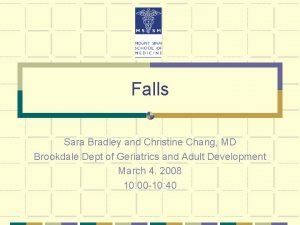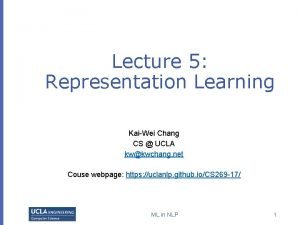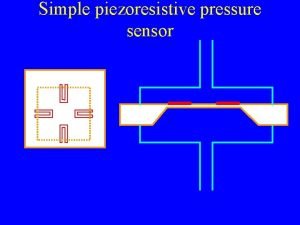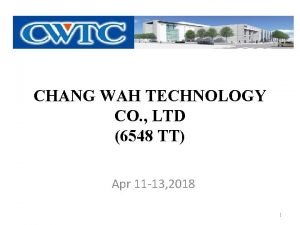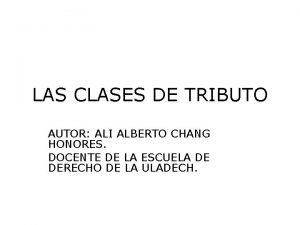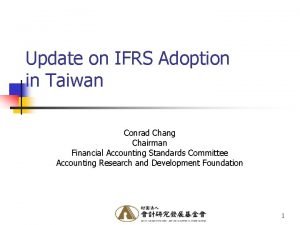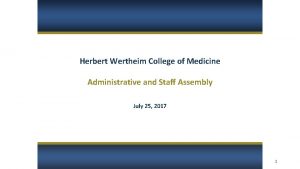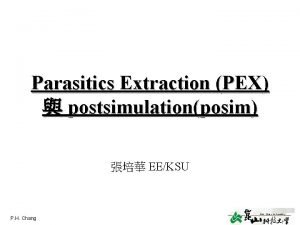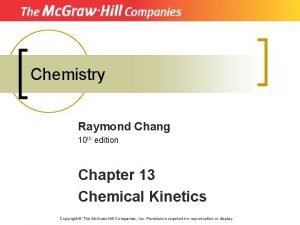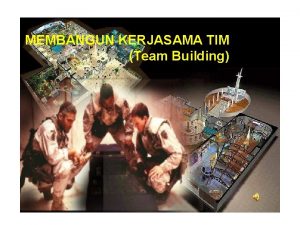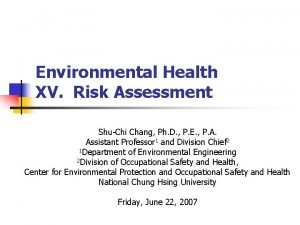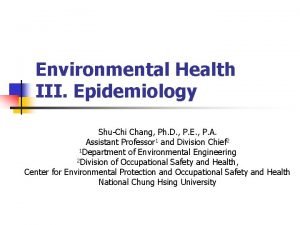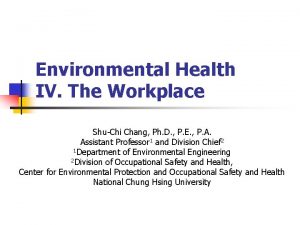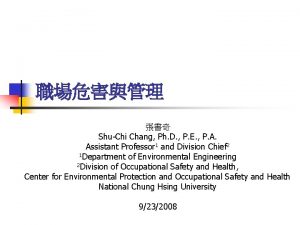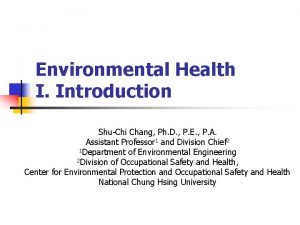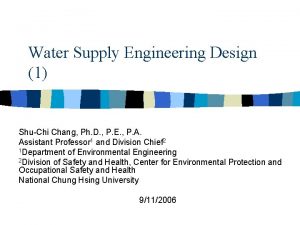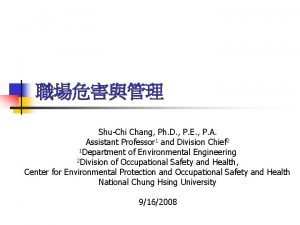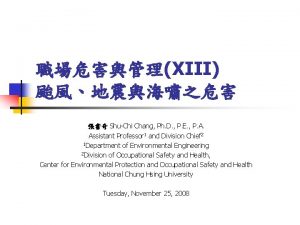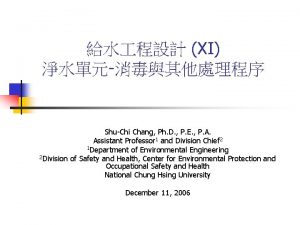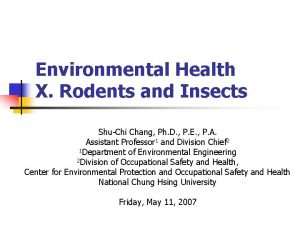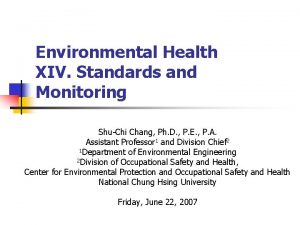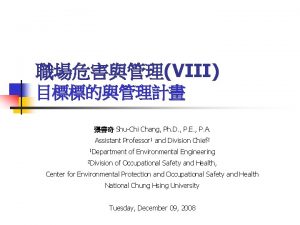V ShuChi Chang Ph D P E P


























































- Slides: 58

職場危害與管理(V) 環安衛管理系統比較與導入 張書奇Shu-Chi Chang, Ph. D. , P. E. , P. A. Assistant Professor 1 and Division Chief 2 1 Department of Environmental Engineering 2 Division of Occupational Safety and Health, Center for Environmental Protection and Occupational Safety and Health National Chung Hsing University Tuesday, October 14, 2008



3. 3 組織 3. 3. 1. The employer should have overall responsibility for the protection of workers' safety and health, and provide leadership for OSH activities in the organization. 3. 3. 2. The employer and senior management should allocate responsibility, accountability and authority for the development, implementation and performance of the OSH management system and the achievement of the relevant OSH objectives. Structures and processes should be established which: (a) ensure that OSH is a line-management responsibility which is known and accepted at all levels; (b) define and communicate to the members of the organization the responsibility, accountability and authority of persons who identify, evaluate or control OSH hazards and risks; (c) provide effective supervision, as necessary, to ensure the protection of workers' safety and health;

3. 3 組織 (續) (d) promote cooperation and communication among members of the organization, including workers and their representatives, to implement the elements of the organization's OSH management system; (e) fulfil the principles of OSH management systems contained in relevant national guidelines, tailored guidelines or voluntary programmes, as appropriate, to which the organization subscribes; (f) establish and implement a clear OSH policy and measurable objectives; (g) establish effective arrangements to identify and eliminate or control work-related hazards and risks, and promote health at work; (h) establish prevention and health promotion programmes; (i) ensure effective arrangements for the full participation of workers and their representatives in the fulfilment of the OSH policy; (j) provide appropriate resources to ensure that persons responsible for OSH, including the safety and health committee, can perform their functions properly; and (k) ensure effective arrangements for the full participation of workers and their representatives in safety and health committees, where they exist.

3. 3組織(續) 3. 3. 3. A person or persons at the senior management level should be appointed, where appropriate, with responsibility, accountability and authority for: (a) the development, implementation, periodic review and evaluation of the OSH management system; (b) periodic reporting to the senior management on the performance of the OSH management system; and (c) promoting the participation of all members of the organization.

3. 4 能力與訓練 3. 4. 1. The necessary OSH competence requirements should be defined by the employer, and arrangements established and maintained to ensure that all persons are competent to carry out the safety and health aspects of their duties and responsibilities. 3. 4. 2. The employer should have, or should have access to, sufficient OSH competence to identify and eliminate or control work-related hazards and risks, and to implement the OSH management system. 3. 4. 3. Under the arrangements referred to in paragraph 3. 4. 1, training programmes should: (a) cover all members of the organization, as appropriate; (b) be conducted by competent persons; (c) provide effective and timely initial and refresher training at appropriate intervals; (d) include participants' evaluation of their comprehension and retention of the training; (e) be reviewed periodically. The review should include the safety and health committee, where it exists, and the training programmes, modified as necessary to ensure their relevance and effectiveness; and (f) be documented, as appropriate and according to the size and nature of activity of the organization. 3. 4. 4. Training should be provided to all participants at no cost and should take place during working hours, if possible.

3. 5 系統文件化 3. 5. 1. According to the size and nature of activity of the organization, OSH management system documentation should be established and maintained, and may cover: (a) the OSH policy and objectives of the organization; (b) the allocated key OSH management roles and responsibilities for the implementation of the OSH management system; (c) the significant OSH hazards/risks arising from the organization's activities, and the arrangements for their prevention and control; and (d) arrangements, procedures, instructions or other internal documents used within the framework of the OSH management system. 3. 5. 2. The OSH management system documentation should be: (a) clearly written and presented in a way that is understood by those who have to use it; and (b) periodically reviewed, revised as necessary, communicated and readily accessible to all appropriate or affected members of the organization.

3. 5 系統文件化 3. 5. 3. OSH records should be established, managed and maintained locally and according to the needs of the organization. They should be identifiable and traceable, and their retention times should be specified. 3. 5. 4. Workers should have the right to access records relevant to their working environment and health, while respecting the need for confidentiality. 3. 5. 5. OSH records may include: (a) records arising from the implementation of the OSH management system; (b) records of work-related injuries, ill health, diseases and incidents; (c) records arising from national laws or regulations dealing with OSH; (d) records of workers' exposures, surveillance of the working environment and workers' health; and (e) the results of both active and reactive monitoring.

3. 4 溝通 3. 6. 1. Arrangements and procedures should be established and maintained for: (a) receiving, documenting and responding appropriately to internal and external communications related to OSH; (b) ensuring the internal communication of OSH information between relevant levels and functions of the organization; and (c) ensuring that the concerns, ideas and inputs of workers and their representatives on OSH matters are received, considered and responded to.



3. 7 先期審查 3. 7. 1. The organization's existing OSH management system and relevant arrangements should be evaluated by an initial review, as appropriate. In the case where no OSH management system exists, or if the organization is newly established, the initial review should serve as a basis for establishing an OSH management system. 3. 7. 2. The initial review should be carried out by competent persons, in consultation with workers and/or their representatives, as appropriate. It should: (a) identify the current applicable national laws and regulations, national guidelines, tailored guidelines, voluntary programmes and other requirements to which the organization subscribes; (b) identify, anticipate and assess hazards and risks to safety and health arising from the existing or proposed work environment and work organization; and (c) determine whether planned or existing controls are adequate to eliminate hazards or control risks; and (d) analyse the data provided from workers' health surveillance. 3. 7. 3. The result of the initial review should: (a) be documented; (b) become the basis for making decisions regarding the implementation of the OSH management system; and (c) provide a baseline from which continual improvement of the organization's OSH management system can be measured.

3. 8 系統規劃與發展 3. 8. 1. The purpose of planning should be to create an OSH management system that supports: (a) as the minimum, compliance with national laws and regulations; (b) the elements of the organization's OSH management system; and (c) continual improvement in OSH performance. 3. 8. 2. Arrangements should be made for adequate and appropriate OSH planning, based on the results of the initial review, subsequent reviews or other available data. These planning arrangements should contribute to the protection of safety and health at work, and should include: (a) a clear definition, priority setting and quantification, where appropriate, of the organization's OSH objectives; (b) the preparation of a plan for achieving each objective, with defined responsibility and clear performance criteria indicating what is to be done by whom and when; (c) the selection of measurement criteria for confirming that the objectives are achieved; and (d) the provision of adequate resources, including human and financial resources and technical support, as appropriate. 3. 8. 3. The OSH planning arrangements of the organization should cover the development and implementation of all the OSH management system elements, as described in Chapter 3 of these guidelines and illustrated in figure 2.

3. 9 職業安全衛生目標 3. 9. 1. Consistent with the OSH policy and based on the initial or subsequent reviews, measurable OSH objectives should be established, which are: (a) specific to the organization, and appropriate to and according to its size and nature of activity; (b) consistent with the relevant and applicable national laws and regulations, and the technical and business obligations of the organization with regard to OSH; (c) focused towards continually improving workers' OSH protection to achieve the best OSH performance; (d) realistic and achievable; (e) documented, and communicated to all relevant functions and levels of the organization; and (f) periodically evaluated and if necessary updated.



3. 10 危害預防 3. 10. 1. Prevention and control measures 3. 10. 1. 1. Hazards and risks to workers' safety and health should be identified and assessed on an ongoing basis. Preventive and protective measures should be implemented in the following order of priority: (a) eliminate the hazard/risk; (b) control the hazard/risk at source, through the use of engineering controls or organizational measures; (c) minimize the hazard/risk by the design of safe work systems, which include administrative control measures; and (d) where residual hazards/risks cannot be controlled by collective measures, the employer should provide for appropriate personal protective equipment, including clothing, at no cost, and should implement measures to ensure its use and maintenance.

3. 10 危害預防 3. 10. 1. 2. Hazard prevention and control procedures or arrangements should be established and should (a) be adapted to the hazards and risks encountered by the organization; (b) be reviewed and modified if necessary on a regular basis; (c) comply with national laws and regulations, and reflect good practice; and (d) consider the current state of knowledge, including information or reports from organizations, such as labour inspectorates, occupational safety and health services, and other services as appropriate.

3. 10 危害預防 (續) 3. 10. 2. Management of change (變動管理) 3. 10. 2. 1. The impact on OSH of internal changes (such as those in staffing or due to new processes, working procedures, organizational structures or acquisitions) and of external changes (for example, as a result of amendments of national laws and regulations, organizational mergers, and developments in OSH knowledge and technology) should be evaluated and appropriate preventive steps taken prior to the introduction of changes. 3. 10. 2. 2. A workplace hazard identification and risk assessment should be carried out before any modification or introduction of new work methods, materials, processes or machinery. Such assessment should be done in consultation with and involving workers and their representatives, and the safety and health committee, where appropriate. 3. 10. 2. 3. The implementation of a "decision to change" should ensure that all affected members of the organization are properly informed and trained

3. 10 危害預防 (續) 3. 10. 3. Emergency prevention, preparedness and response 3. 10. 3. 1. Emergency prevention, preparedness and response arrangements should be established and maintained. These arrangements should identify the potential for accidents and emergency situations, and address the prevention of OSH risks associated with them. The arrangements should be made according to the size and nature of activity of the organization. They should: (a) ensure that the necessary information, internal communication and coordination are provided to protect all people in the event of an emergency at the worksite; (b) provide information to, and communication with, the relevant competent authorities, and the neighbourhood and emergency response services; (c) address first-aid and medical assistance, firefighting and evacuation of all people at the worksite; and (d) provide relevant information and training to all members of the organization, at all levels, including regular exercises in emergency prevention, preparedness and response procedures. 3. 10. 3. 2. Emergency prevention, preparedness and response arrangements should be established in cooperation with external emergency services and other bodies where applicable.

3. 10 危害預防 (續) 3. 10. 4. Procurement 3. 10. 4. 1. Procedures should be established and maintained to ensure that: (a) compliance with safety and health requirements for the organization is identified, evaluated and incorporated into purchasing and leasing specifications; (b) national laws and regulations and the organization's own OSH requirements are identified prior to the procurement of goods and services; and (c) arrangements are made to achieve conformance to the requirements prior to their use.

3. 10 危害預防 (續) 3. 10. 5. Contracting 3. 10. 5. 1. Arrangements should be established and maintained for ensuring that the organization's safety and health requirements, or at least the equivalent, are applied to contractors and their workers. 3. 10. 5. 2. Arrangements for contractors working on site should: (a) include OSH criteria in procedures for evaluating and selecting contractors; (b) establish effective ongoing communication and coordination between appropriate levels of the organization and the contractor prior to commencing work. This should include provisions for communicating hazards and the measures to prevent and control them; (c) include arrangements for reporting of work-related injuries, ill health, diseases and incidents among the contractors' workers while performing work for the organization; (d) provide relevant workplace safety and health hazard awareness and training to contractors or their workers prior to commencing work and as work progresses, as necessary; (e) regularly monitor OSH performance of contractor activities on site; and (f) ensure that on-site OSH procedures and arrangements are followed by the contractor(s).



















3. 11 評價 3. 11. Performance monitoring and measurement 3. 11. 1. Procedures to monitor, measure and record OSH performance on a regular basis should be developed, established and periodically reviewed. Responsibility, accountability and authority for monitoring at different levels in the management structure should be allocated. 3. 11. 2. The selection of performance indicators should be according to the size and nature of activity of the organization and the OSH objectives. 3. 11. 3. Both qualitative and quantitative measures appropriate to the needs of the organization should be considered. These should: (a) be based on the organization's identified hazards and risks, the commitments in the OSH policy and the OSH objectives; and (b) support the organization's evaluation process, including the management review.

3. 11 評價 3. 11. 4. Performance monitoring and measurement should: (a) be used as a means of determining the extent to which OSH policy and objectives are being implemented and risks are controlled; (b) include both active and reactive monitoring, and not be based only upon work-related injury, ill health, disease and incident statistics; and (c) be recorded. 3. 11. 5. Monitoring should provide: (a) feedback on OSH performance; (b) information to determine whether the day-to-day arrangements for hazard and risk identification, prevention and control are in place and operating effectively; and (c) the basis for decisions about improvement in hazard identification and risk control, and the OSH management system.

3. 11 評價 3. 11. 6. Active monitoring should contain the elements necessary to have a proactive system and should include: (a) monitoring of the achievement of specific plans, established performance criteria and objectives; (b) the systematic inspection of work systems, premises, plant and equipment; (c) surveillance of the working environment, including work organization; (d) surveillance of workers' health, where appropriate, through suitable medical monitoring or follow-up of workers for early detection of signs and symptoms of harm to health in order to determine the effectiveness of prevention and control measures; and (e) compliance with applicable national laws and regulations, collective agreements and other commitments on OSH to which the organization subscribes.

3. 11 評價 3. 11. 7. Reactive monitoring should include the identification, reporting and investigation of: (a) work-related injuries, ill health (including monitoring of aggregate sickness absence records), diseases and incidents; (b) other losses, such as damage to property; (c) deficient safety and health performance, and OSH management system failures; and (d) workers' rehabilitation and health-restoration programmes.

3. 12 Investigation of workrelated injuries…… 3. 12. Investigation of work-related injuries, ill health, diseases and incidents, and their impact on safety and health performance 3. 12. 1. The investigation of the origin and underlying causes of work-related injuries, ill health, diseases and incidents should identify any failures in the OSH management system and should be documented. 3. 12. 2. Such investigations should be carried out by competent persons, with the appropriate participation of workers and their representatives. 3. 12. 3. The results of such investigations should be communicated to the safety and health committee, where it exists, and the committee should make appropriate recommendations. 3. 12. 4. The results of investigations, in addition to any recommendations from the safety and health committee, should be communicated to appropriate persons for corrective action, included in the management review and considered for continual improvement activities. 3. 12. 5. The corrective action resulting from such investigations should be implemented in order to avoid repetition of work-related injuries, ill health, diseases and incidents. 3. 12. 6. Reports produced by external investigative agencies, such as inspectorates and social insurance institutions, should be acted upon in the same manner as internal investigations, taking into account issues of confidentiality.

3. 13. Audit 3. 1. Arrangements to conduct periodic audits are to be established in order to determine whether the OSH management system and its elements are in place, adequate, and effective in protecting the safety and health of workers and preventing incidents. 3. 13. 2. An audit policy and programme should be developed, which includes a designation of auditor competency, the audit scope, the frequency of audits, audit methodology and reporting.

3. 13. Audit 3. 13. 3. The audit includes an evaluation of the organization's OSH management system elements or a subset of these, as appropriate. The audit should cover: (a) OSH policy; (b) worker participation; (c) responsibility and accountability; (d) competence and training; (e) OSH management system documentation; (f) communication; (g) system planning, development and implementation; (h) prevention and control measures; (i) management of change; (j) emergency prevention, preparedness and response; (k) procurement; (l) contracting; (m) performance monitoring and measurement; (n) investigation of work-related injuries, ill health, diseases and incidents, and their impact on safety and health performance; (o) audit; (p) management review; (q) preventive and corrective action; (r) continual improvement; and (s) any other audit criteria or elements that may be appropriate.

3. 13. Audit 3. 13. 4. The audit conclusion should determine whether the implemented OSH management system elements or a subset of these: (a) are effective in meeting the organization's OSH policy and objectives; (b) are effective in promoting full worker participation; (c) respond to the results of OSH performance evaluation and previous audits; (d) enable the organization to achieve compliance with relevant national laws and regulations; and (e) fulfil the goals of continual improvement and best OSH practice. 3. 13. 5. Audits should be conducted by competent persons internal or external to the organization who are independent of the activity being audited. 3. 13. 6. The audit results and audit conclusions should be communicated to those responsible for corrective action. 3. 13. 7. Consultation on selection of the auditor and all stages of the workplace audit, including analysis of results, are subject to worker participation, as appropriate.



3. 14 管理審查 3. 14. 1. Management reviews should: (a) evaluate the overall strategy of the OSH management system to determine whether it meets planned performance objectives; (b) evaluate the OSH management system's ability to meet the overall needs of the organization and its stakeholders, including its workers and the regulatory authorities; (c) evaluate the need for changes to the OSH management system, including OSH policy and objectives; (d) identify what action is necessary to remedy any deficiencies in a timely manner, including adaptations of other aspects of the organization's management structure and performance measurement; (e) provide the feedback direction, including the determination of priorities, for meaningful planning and continual improvement; (f) evaluate progress towards the organization's OSH objectives and corrective action activities; and (g) evaluate the effectiveness of follow-up actions from earlier management reviews.

3. 12 管理審查 3. 14. 2. The frequency and scope of periodic reviews of the OSH management system by the employer or the most senior accountable person should be defined according to the organization's needs and conditions. 3. 14. 3. The management review should consider: (a) the results of work-related injuries, ill health, diseases and incident investigations; performance monitoring and measurement; and audit activities; and (b) additional internal and external inputs as well as changes, including organizational changes, that could affect the OSH management system. 3. 14. 4. The findings of the management review should be recorded and formally communicated to: (a) the persons responsible for the relevant element(s) of the OSH management system so that they may take appropriate action; and (b) the safety and health committee, workers and their representatives.

Action for improvement 3. 15. Preventive and corrective action 3. 15. 1. Arrangements should be established and maintained for preventive and corrective action resulting from OSH management system performance monitoring and measurement, OSH management system audits and management reviews. These arrangements should include: (a) identifying and analysing the root causes of any non-conformities with relevant OSH regulations and/or OSH management systems arrangements; and (b) initiating, planning, implementing, checking the effectiveness of and documenting corrective and preventive action, including changes to the OSH management system itself. 3. 15. 2. When the evaluation of the OSH management system or other sources show that preventive and protective measures for hazards and risks are inadequate or likely to become inadequate, the measures should be addressed according to the recognized hierarchy of prevention and control measures, and completed and documented, as appropriate and in a timely manner.

3. 16. Continual improvement 3. 16. 1. Arrangements should be established and maintained for the continual improvement of the relevant elements of the OSH management system and the system as a whole. These arrangements should take into account: (a) the OSH objectives of the organization; (b) the results of hazard and risk identifications and assessments; (c) the results of performance monitoring and measurements; (d) the investigation of work-related injuries, diseases, ill health and incidents, and the results and recommendations of audits; (e) the outcomes of the management review; (f) the recommendations for improvement from all members of the organization, including the safety and health committee, where it exists; (g) changes in national laws and regulations, voluntary programmes and collective agreements; (h) new relevant information; and (i) the results of health protection and promotion programmes. 3. 16. 2. The safety and health processes and performance of the organization should be compared with others in order to improve health and safety performance.



 Shuchi chawla
Shuchi chawla Shuchi chawla
Shuchi chawla Zeinab chahine
Zeinab chahine _faychang_
_faychang_ Paoti chang
Paoti chang Sara bradley md
Sara bradley md Peter chang biography
Peter chang biography Chang cgi
Chang cgi Johan chang
Johan chang Chúa chăn nuôi tôi, tôi chẳng thiếu thốn chi
Chúa chăn nuôi tôi, tôi chẳng thiếu thốn chi Yifan chang
Yifan chang Kaiwei chang
Kaiwei chang Ching chang walla song
Ching chang walla song Natural language processing
Natural language processing Jichuan chang
Jichuan chang Adxl 50
Adxl 50 Chia hui chang
Chia hui chang Ksk+
Ksk+ Chang wah technology
Chang wah technology Chớ mang ách chung với kẻ chẳng tin
Chớ mang ách chung với kẻ chẳng tin _faychang_
_faychang_ Youngho chang
Youngho chang Remco chang
Remco chang Post classical vietnam
Post classical vietnam Chẳng nhìn thấy ve đâu
Chẳng nhìn thấy ve đâu Angel xuan chang
Angel xuan chang Hee chang trading co ltd
Hee chang trading co ltd Chang
Chang Pien fu clothing
Pien fu clothing Alberto chang
Alberto chang Darrick chang
Darrick chang Wilke chang
Wilke chang Jichuan chang
Jichuan chang Chia hui chang
Chia hui chang Chang pui chung memorial school
Chang pui chung memorial school Chang g lai
Chang g lai Khởi nghĩa chàng lía nổ ra ở đâu
Khởi nghĩa chàng lía nổ ra ở đâu Mitchell chang ucla
Mitchell chang ucla Joe chang
Joe chang Eileen chang love in a fallen city summary
Eileen chang love in a fallen city summary Chang horing
Chang horing Conrad chang
Conrad chang Winnie chang fiu
Winnie chang fiu Hạng a cháng là ai
Hạng a cháng là ai Yuyen chang
Yuyen chang Ph chang
Ph chang Ming-wei chang
Ming-wei chang Kai wei chang
Kai wei chang Chemistry by raymond chang 10th edition
Chemistry by raymond chang 10th edition Chang'an
Chang'an Chẳng may em đánh vỡ một lọ hoa đẹp
Chẳng may em đánh vỡ một lọ hoa đẹp Thêu lát khoán vảy
Thêu lát khoán vảy Kerjasama kata majmuk
Kerjasama kata majmuk Bor-yuh evan chang
Bor-yuh evan chang Tc chang
Tc chang Najdlhšia ázijská rieka
Najdlhšia ázijská rieka Ao and chang language
Ao and chang language Rong chang dictation
Rong chang dictation





